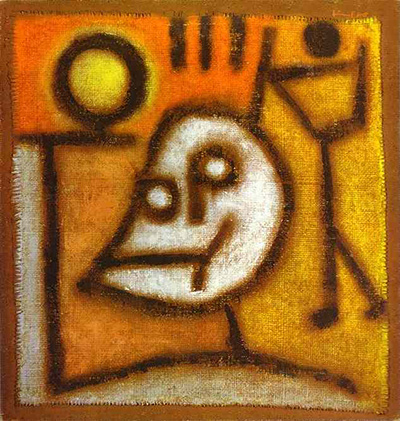Paul Klee painted Death and Fire in 1940, just a few months before his death in the June of that year.
He had been suffering from a condition now known as scleroderma since about 1935. The condition caused fatigue, rashes and painful joints in his hands. As a result his work grew more simplistic yet this painting titled "Death and Fire" holds a powerful message.
This highly expressionist piece was painted using oils on distemper on jute.
It used few colours, the bright oranges and yellows contrasting with the white and thick, black lines.
Some writers have likened it to a cave-painting. Certainly Klee had been influenced by primitive and tribal art in the past but his health and physical condition must also have had a great impact on the style of this painting.
In Death and Fire a face appears in white holding a glowing orb in its hand. To the right of the image another simplified figure walks across the image towards the glowing orb. Typically of Klee, he ensures that he gets his message across. The German word for "death" is "tod".
If the viewer turns their head and looks carefully at the white face, they can see that the mouth forms the letter "T" and the eyes form the letters "o" and "d". The message is repeated again as the figure's arm forms the letter "T" which holds the letter "O" while the head of the figure forms the letter "D". It seems that Klee was desperately shouting out his message in this piece.
The simplistic and striking form of the image compels the viewer to look at it but at the same time the white face can appear rather grotesque. The overall picture, which has a rather childlike quality at first glance, combined with the warm, fire-like glow and the messages of "tod", conjures up a range of conflicting emotions within the viewer.
In 2014 the painting was placed on display in Bern, Switzerland in a museum dedicated to this very talented artist.




